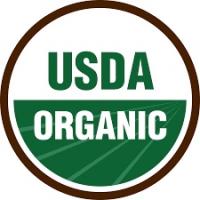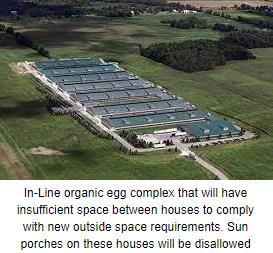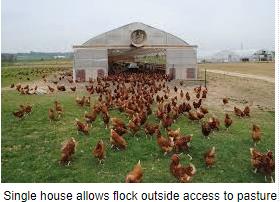 On October 25th, Secretary of the USDA, Tom Vilsack, signed off on the Organic Livestock and Poultry Standards final rule (OLPS). The latest OLSP regulations are framed in terms of 7 CFR Lot 205 and refer to DOC, AMS, NOP21-0073.
On October 25th, Secretary of the USDA, Tom Vilsack, signed off on the Organic Livestock and Poultry Standards final rule (OLPS). The latest OLSP regulations are framed in terms of 7 CFR Lot 205 and refer to DOC, AMS, NOP21-0073.
This is the second time that Secretary Vilsack has approved an updated organic standards rule for poultry. During the Obama Administration, requirements were developed and issued on the last day of his first tenure as USDA Secretary. Almost immediately on assuming the position of Secretary of Agriculture, Dr. Sonny Perdue, the successor to Sec. Vilsack, cancelled the first revision of the OLPS. Organic egg producers have continued to operate in accordance with pre-2017 standards that are vague with respect to outside access and allowed enclosed sun porches to be counted as outside area.
The following changes will be required in terms of the 2023 OLPS with an appropriate grandfathering of existing facilities and allowing 15 years for depreciation of in-line units: -
- For houses with solid or slatted floors, 15 percent of the floor area must be covered with litter to allow dust-bathing and other natural activities.
- For floor-housed flocks, six inches of perch space must be provided per hen including the alighting rails in front of nests. Floor slats will no longer be regarded as perches.
- Indoor space is based on the weight of a hen and will comprise three pounds of hen weight per square foot or 2.2 ft2 per bird. Existing sun porches will be regarded as part of the enclosed area of the house and will not be counted as outside access.
- Outside access shall comprise at least 75 percent soil covered with vegetation. Outside area will be 1ft2 per 2.25 pounds corresponding to approximately 2 ft2 per 4.5-pound mature hen.
- Pullets should be allowed an outside area requirement of 1.7 ft2.
- Flocks should be allowed outside access throughout the year with a proviso that below 32F or above 90F, hens may be retained under roof cover in houses.
- Openings to allow outside access (’pop-holes’) should allow a minimum of 1 linear foot per 360 birds.
- Eight hours of darkness should be allowed for each 24-hour period.
- Producers should implement acceptable health care practices requiring administration of therapy even if this disqualifies the flock from organic production.

USDA-AMS maintain that the revised OLPS Final Rule was based on demand from consumers and cites 40,000 written comments that were reviewed before drafting the final rule.
The regulations, with respect to outside access and the disqualification of sun porches, are directed against large in-line, currently certified organic complexes. It is a matter of record that these units produce in excess of 50 percent of current U.S. organic egg production. Accordingly, producers using barns on the small-scale units operated by contractors or independents will benefit from the OLPSs since supply will be reduced with a corresponding increase in price at the retail shelf. Whether contractors or small independents will benefit financially will only be answered over time.
It is likely that when the grace period expires, the large segment of the industry operating complexes with sun porches may well develop their own market designation incorporating organic feed, freedom from antibiotics, acceptable floor space in aviaries, use of sun porches but without or allowing limited outside access.
The question of outside access is a point of contention. There is no nutritional value accruing from exposure to either soil or vegetation. There is no definitive evidence that hens prefer extended periods of outside access compared to aviary or barn housing. This is based on an inherent fear of predators and is evidenced by the disinclination of flocks to venture outside houses or to stray any distance from their ‘pop-holes’. Birds allowed outside access are vulnerable to predation and are exposed to bacteria, protozoa and helminth parasites. In recent years in both the E.U. and the U.S., avian influenza disseminated by migratory waterfowl has resulted in either recommendations or mandates that all flocks be retained in housing during risk periods.
 The amended OLPS has strong overtones of protectionism for a specific segment of organic egg production. If not subsequently modified or rescinded the more extreme provisions will ultimately serve to the disadvantage of large-scale producers and ultimately consumers who will pay a higher price for USDA Certified Organic eggs. Even with the current relaxed standards for outside access, organic egg production is almost static representing a declining proportion of non-caged birds. During the third quarter of 2022, 18 million organic hens represented 17.1 percent of all cage-free hens. By the third quarter of 2023 organic hens have increased by 3.3 percent to 18.6 million comprising 13.2 percent of the national flock housed in other than conventional cages. During the same period ‘cage-free” hens (other than USDA Certified Organic) increased by 19.5 percent to 104 million.
The amended OLPS has strong overtones of protectionism for a specific segment of organic egg production. If not subsequently modified or rescinded the more extreme provisions will ultimately serve to the disadvantage of large-scale producers and ultimately consumers who will pay a higher price for USDA Certified Organic eggs. Even with the current relaxed standards for outside access, organic egg production is almost static representing a declining proportion of non-caged birds. During the third quarter of 2022, 18 million organic hens represented 17.1 percent of all cage-free hens. By the third quarter of 2023 organic hens have increased by 3.3 percent to 18.6 million comprising 13.2 percent of the national flock housed in other than conventional cages. During the same period ‘cage-free” hens (other than USDA Certified Organic) increased by 19.5 percent to 104 million.
Producers promoting more rigid standards for outside access without scientific justification other than fragmentary directed research may wish to take stock of their actions. Sharply increased shelf prices will reduce total sales of organic eggs. High-priced product bearing the USDA certified organic seal will have to compete with alternative products offering similar claims including GMO-free feed, superior food safety and availability favored as attributes by consumers. The OLPS final rule illustrates the adage that sometimes one may regret getting what is prayed for.